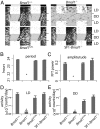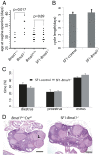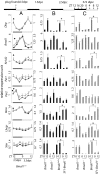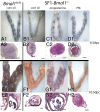Loss of BMAL1 in ovarian steroidogenic cells results in implantation failure in female mice
- PMID: 25225411
- PMCID: PMC4191810
- DOI: 10.1073/pnas.1209249111
Loss of BMAL1 in ovarian steroidogenic cells results in implantation failure in female mice
Abstract
The circadian clock plays a significant role in many aspects of female reproductive biology, including estrous cycling, ovulation, embryonic implantation, onset of puberty, and parturition. In an effort to link cell-specific circadian clocks to their specific roles in female reproduction, we used the promoter that controls expression of Steroidogenic Factor-1 (SF1) to drive Cre-recombinase-mediated deletion of the brain muscle arnt-like 1 (Bmal1) gene, known to encode an essential component of the circadian clock (SF1-Bmal1(-/-)). The resultant SF1-Bmal1(-/-) females display embryonic implantation failure, which is rescued by progesterone supplementation, or bilateral or unilateral transplantation of wild-type ovaries into SF1-Bmal1(-/-) dams. The observation that the central clock, and many other peripheral clocks, are fully functional in this model allows the assignment of the implantation phenotype to the clock in ovarian steroidogenic cells and distinguishes it from more general circadian related systemic pathology (e.g., early onset arthropathy, premature aging, ovulation, late onset of puberty, and abnormal estrous cycle). Our ovarian transcriptome analysis reveals that deletion of ovarian Bmal1 disrupts expression of transcripts associated with the circadian machinery and also genes critical for regulation of progesterone production, such as steroidogenic acute regulatory factor (Star). Overall, these data provide a powerful model to probe the interlocking and synergistic network of the circadian clock and reproductive systems.
Keywords: circadian rhythm; fertility; ovary; steroidogenesis.
Conflict of interest statement
The authors declare no conflict of interest.
Figures





Comment in
-
Reproductive endocrinology: circadian clock involved in embryo implantation.Nat Rev Endocrinol. 2014 Dec;10(12):701. doi: 10.1038/nrendo.2014.174. Epub 2014 Oct 7. Nat Rev Endocrinol. 2014. PMID: 25287286 No abstract available.
References
Publication types
MeSH terms
Substances
Associated data
- Actions
Grants and funding
LinkOut - more resources
Full Text Sources
Other Literature Sources
Molecular Biology Databases

